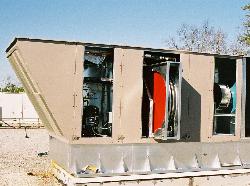Advantages and Applications of Desiccant Dehumidification
Desiccant systems are suitable to any facility where humidity control is required or where the ratio of latent to sensible cooling load is high. Desiccant dehumidification has successfully helped:
- Supermarkets eliminate frost build-up on frozen foods, freezer case coils and freezer case doors; reduce sweat on refrigerated cases; significantly reduce electricity usage; and maintain a more comfortable shopping environment
- Offices and retail stores eliminate sick building syndrome; lower relative humidity; and improve indoor air quality
- Hotels eliminate mold, mildew and musty odors
- Industry eliminate problems in the manufacture of moisture-sensitive products
- Ice rinks improve ice quality, prevent rust and mildew, and prevent the formation of fog
- Hospitals provide flexible temperature and humidity controls for operating rooms and minimize bacterial growth
- Quick-service restaurants improve customer comfort and eliminate odors
- Schools and theaters counteract the effects of human respiration in densely populated facilities
Liquid desiccant systems are often the preferred choice for challenging process dehumidification needs, for applications where high volumes of precisely conditioned air are needed for food processing, and for large-scale digital circuit manufacturing operations.

Desiccant dehumidification offers these important advantages:
- Reduces growth of disease-causing microbes
- Controls odors, mold and mildew
- Eliminates condensation
- Increases comfort of building occupants
- Prevents damage to furnishings, carpeting, tiles, and other building materials
- Saves energy
- Reduces operating costs
- Reduces conventional cooling requirements
- Improves efficiency of chillers
- Ensures more precise temperature and humidity control
When comparing desiccant systems, careful consideration and evaluation must be given to capacity and efficiency measures. Desiccant systems can be rated in terms of water removal (lbs/hr), airflow capacity (cfm), or cooling capacity (tons). Currently, no industry accepted methods exist for calculating a desiccant unit’s coefficient of performance (COP). And, desiccant systems cannot simply be substituted for alternative cooling systems on a ton-for-ton basis. Conditions and requirements can vary considerably between sites, so it is essential that each application be evaluated separately to determine the optimum system configuration. Consult equipment manufacturers for more information about evaluating their equipment.
Desiccant dehumidification can help reduce or eliminate excess moisture and related problems in the building environment. The following case studies demonstrates what happens when gas technologies are applied to real-world situations.
The following case studies require Adobe® Acrobat® Reader which is available here.
Natural gas for flexibility and savings — Schwan’s Super Rink Blaine, MN
Natural gas engine-driven chiller and desiccant dehumidification fueled by engine waste heat keep ice and air clear and costs down.
Gas Ops Installs New Service at the National Guard Armory – Fort Pierce Utility Authority, FL
U.S. Army depends on natural gas desiccant wheel dehumidifiers to maintain proper atmosphere for sensitive weaponry and systems.
